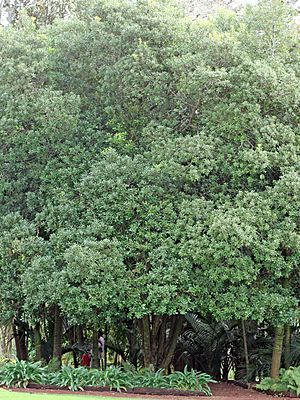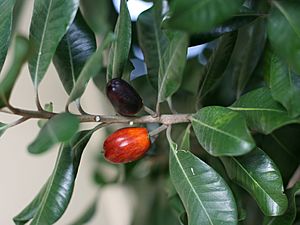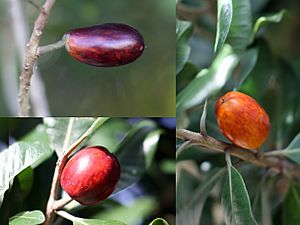Pouteria costata facts for kids
Quick facts for kids Pouteria costata |
|
|---|---|
 |
|
| Scientific classification | |
| Genus: |
Pouteria
|
| Species: |
costata
|
 |
|
| Natural range of Pouteria costata | |
| Synonyms | |
|
Planchonella costata |
|
The Pouteria costata is a small tree that grows near the coast. You can find it in the northern part of the North Island in New Zealand. It also grows on Norfolk Island in Australia.
In New Zealand, people call this tree tawapou (which is "tawāpou" in Māori). On Norfolk Island, it's known as bastard ironwood. The scientific name costata comes from a Latin word meaning "ribbed." This refers to the clear raised lines you can see on its leaves. The Pouteria group of trees has about 300 different kinds found in warm parts of America, Asia, Australia, and the Pacific.
Contents
About Its Name
The tawapou tree has had a few different scientific names over time. Scientists sometimes change names as they learn more about plants. Some experts think it belongs to the Pouteria group, while others prefer Planchonella. Another scientific name for this tree was Pouteria novo-zelandica.
Where Tawapou Trees Grow
On Norfolk Island, the Pouteria costata is quite rare. It grows in forests and on a place called Mt Pitt. Because it's so rare there, it's listed as an 'endangered' plant under Australian law.
In New Zealand, the tawapou tree grows in certain spots along the northern coasts of the North Island. You can find it on islands like the Three Kings Islands. It also grows on headlands from North Cape down to Tolaga Bay on the east coast. On the west coast, it reaches as far as the Manukau Harbour.
This tree often grows alongside other native trees like pohutukawa, karaka, and taraire. It can grow from sea level up to about 450 meters high, but always close to the ocean. In New Zealand, it is not considered to be in danger.
What the Tawapou Tree Looks Like
The Pouteria costata is a tree that grows slowly. It has many branches and prefers to live near the coast. It can grow up to 20 meters tall, with a trunk that can be 1 meter wide. The bark is rough and can be grey or brownish-grey.
This tree likes a bit of shade and doesn't do well in frost. Its leaves are a shiny dark green. They are usually 5 to 10 cm long and 2 to 5 cm wide. You can clearly see the main vein in the middle of the leaf, as well as 14 to 20 other veins on each side. The small branches and leaf stems have tiny, flat hairs.
The flowers are very small, only 4–6 mm across. They usually grow where the leaves meet the branch, but can also grow directly from the branches.
The tree produces large, colorful berries that are 2.5 to 4 cm long. Inside each berry are 2 to 4 hard, shiny seeds. These seeds are almost as long as the berry itself. The Māori used these seeds to make necklaces.
The berries change color as they ripen. They start green, then turn orange, and finally become a very dark red. This process can take a long time, from 12 to 15 months. The berries are heavy and can fall easily if the tree is shaken. When the tree is hurt, it lets out a sticky, white sap. The wood of the tawapou tree is white, hard, and lasts a long time.
Birds like the kereru (New Zealand pigeon) and the kaka parrot eat the fruit. Similar birds on Norfolk Island, which are now extinct, also ate these berries.
Challenges for Tawapou Trees
The fruit and seeds of the tawapou tree are very tasty to rats. In New Zealand, studies have shown that rats, especially the kiore (Pacific rat), have greatly reduced the number of tawapou trees. They have also changed the types of plants found in coastal forests in the northern North Island.
Kiore were brought to New Zealand by Māori about 1,000 years ago. They spread across the main islands and many smaller islands. Today, you rarely find young tawapou trees on the mainland or on islands where kiore are present. But on islands where there are no rats, young tawapou trees are common.
Where kiore are present, it's rare to find tawapou seeds that haven't been eaten. Kiore eat the soft part of the fallen fruit. They often take the seeds to special "eating spots" where they remove the inside kernel. Scientists have found as many as 1,400 empty seed husks at one spot!
When rats are removed from an island, the number of young tawapou trees grows a lot. This shows that rats can stop many new trees from growing. If rats are removed from an island, the number of tawapou trees will increase. Norfolk Island also has different kinds of rats, which likely contributes to why the Pouteria costata is endangered there.
Tawapou in Māori Culture
Māori people often used tawapou logs as rollers to help pull large canoes onto the shore. In Māori stories from Northland, it's said that the 'Waipapa' canoe landed in Doubtless Bay. The captain asked his crew to plant the canoe rollers, which they had brought from Hawaiki, on a nearby hill. From these rollers grew a group of tawapou trees. These trees still stand today as a reminder of the canoe's arrival.
Similar stories are told about tawapou groves at Houhoura Harbour and Aurere Beach. The Mamaru canoe, whose descendants live around Doubtless Bay and near Kaitaia, had an important ancestor named Pou among its crew. It's possible that the name 'tawāpou' comes from 'Tawa-a-Pou', meaning 'the Tawa trees of Pou'.
Another legend from East Cape tells of the Takitimu canoe. A flock of kaka parrots followed it when it left Hawaiki. They ate many tawapou berries to give them energy for the long flight. When they reached East Cape, they dropped the seeds, which grew into trees. Eventually, tawapou trees spread all along the coast.
Images for kids
See also
 In Spanish: Pouteria costata para niños
In Spanish: Pouteria costata para niños





